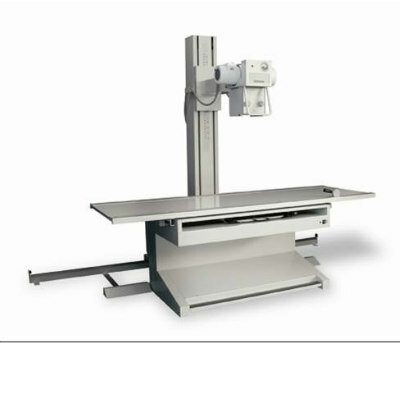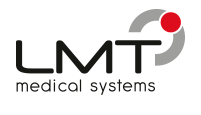Novel CT Scanner Automates Time-Consuming Radiologic Tasks
|
By MedImaging International staff writers Posted on 06 Oct 2021 |

Image: The Revolution Ascend CT scanner (Photo courtesy of GE Healthcare)
A new computerized tomography (CT) scanner offers clinicians a host of artificial intelligence (AI) technologies to optimize scan range settings, dose, and image quality for each patient.
The GE Healthcare (Chicago, IL, USA) Revolution Ascend CT system offers a 75 cm wide-gantry and lower table position to accommodate high body mass index (BMI) patients, as well as trauma cases that would otherwise be too fragile to maneuver into smaller gantries. The physical properties are accompanied by Effortless Workflow, a new suite of AI solutions that require significantly less effort from the CT technologist.
The system’s attached bar code reader scans the patient’s chart or tag and personalizes each exam by automatically pulling up the patient’s information and suggesting relevant protocols. With one click, the CT technologist can then initiate Auto Positioning, which uses real-time depth-sensing technology to generate a 3D model of the patient’s body and determine the correct table elevation and cradle movements to align the center of the scan range with the isocenter of the bore.
Once the patient is ready to be scanned, intelligent tools embedded in the new Clarity Operator Environment provide optimal scan range settings, dose, and image quality for each individual. A dedicated deep convoluted neural network (CNN) is then used to generate TrueFidelity CT Images that improve reading confidence in a wide range of clinical applications, such as head, whole body, and cardiovascular, for patients of all ages.
“We designed Revolution Ascend with accessibility in mind. Not only does the system’s hardware help accommodate more patients with various physical limitations, but its cutting-edge AI also helps expedite exams so healthcare system schedules can accommodate additional patient scans,” said Jean-Luc Procaccini, President and CEO of molecular imaging and CT at GE Healthcare. “Altogether, Revolution Ascend with Effortless Workflow helps empower clinicians to reach the right diagnosis as efficiently and precisely as possible for more patients.”
“The most time-consuming part of the CT experience isn’t the scan itself, but the steps that fall outside the scan,” said Timothy Szczykutowicz, PhD, of the University of Wisconsin (Madison, USA). “Within a typical 10–30-minute CT exam, the scan itself only takes a few minutes and the remainder of the time is dedicated to patient prep, including positioning the patient and identifying the correct protocols and settings, plus image reconstruction and report time. Historically, these have been manual processes, putting them at risk of human error; however, AI offers new opportunities to automate workflows and expedite exams with the same or better results.”
Related Links:
GE Healthcare
The GE Healthcare (Chicago, IL, USA) Revolution Ascend CT system offers a 75 cm wide-gantry and lower table position to accommodate high body mass index (BMI) patients, as well as trauma cases that would otherwise be too fragile to maneuver into smaller gantries. The physical properties are accompanied by Effortless Workflow, a new suite of AI solutions that require significantly less effort from the CT technologist.
The system’s attached bar code reader scans the patient’s chart or tag and personalizes each exam by automatically pulling up the patient’s information and suggesting relevant protocols. With one click, the CT technologist can then initiate Auto Positioning, which uses real-time depth-sensing technology to generate a 3D model of the patient’s body and determine the correct table elevation and cradle movements to align the center of the scan range with the isocenter of the bore.
Once the patient is ready to be scanned, intelligent tools embedded in the new Clarity Operator Environment provide optimal scan range settings, dose, and image quality for each individual. A dedicated deep convoluted neural network (CNN) is then used to generate TrueFidelity CT Images that improve reading confidence in a wide range of clinical applications, such as head, whole body, and cardiovascular, for patients of all ages.
“We designed Revolution Ascend with accessibility in mind. Not only does the system’s hardware help accommodate more patients with various physical limitations, but its cutting-edge AI also helps expedite exams so healthcare system schedules can accommodate additional patient scans,” said Jean-Luc Procaccini, President and CEO of molecular imaging and CT at GE Healthcare. “Altogether, Revolution Ascend with Effortless Workflow helps empower clinicians to reach the right diagnosis as efficiently and precisely as possible for more patients.”
“The most time-consuming part of the CT experience isn’t the scan itself, but the steps that fall outside the scan,” said Timothy Szczykutowicz, PhD, of the University of Wisconsin (Madison, USA). “Within a typical 10–30-minute CT exam, the scan itself only takes a few minutes and the remainder of the time is dedicated to patient prep, including positioning the patient and identifying the correct protocols and settings, plus image reconstruction and report time. Historically, these have been manual processes, putting them at risk of human error; however, AI offers new opportunities to automate workflows and expedite exams with the same or better results.”
Related Links:
GE Healthcare
Latest Radiography News
- Novel Breast Imaging System Proves As Effective As Mammography
- AI Assistance Improves Breast-Cancer Screening by Reducing False Positives
- AI Could Boost Clinical Adoption of Chest DDR
- 3D Mammography Almost Halves Breast Cancer Incidence between Two Screening Tests
- AI Model Predicts 5-Year Breast Cancer Risk from Mammograms
- Deep Learning Framework Detects Fractures in X-Ray Images With 99% Accuracy
- Direct AI-Based Medical X-Ray Imaging System a Paradigm-Shift from Conventional DR and CT
- Chest X-Ray AI Solution Automatically Identifies, Categorizes and Highlights Suspicious Areas
- AI Diagnoses Wrist Fractures As Well As Radiologists
- Annual Mammography Beginning At 40 Cuts Breast Cancer Mortality By 42%
- 3D Human GPS Powered By Light Paves Way for Radiation-Free Minimally-Invasive Surgery
- Novel AI Technology to Revolutionize Cancer Detection in Dense Breasts
- AI Solution Provides Radiologists with 'Second Pair' Of Eyes to Detect Breast Cancers
- AI Helps General Radiologists Achieve Specialist-Level Performance in Interpreting Mammograms
- Novel Imaging Technique Could Transform Breast Cancer Detection
- Computer Program Combines AI and Heat-Imaging Technology for Early Breast Cancer Detection
Channels
MRI
view channel
PET/MRI Improves Diagnostic Accuracy for Prostate Cancer Patients
The Prostate Imaging Reporting and Data System (PI-RADS) is a five-point scale to assess potential prostate cancer in MR images. PI-RADS category 3 which offers an unclear suggestion of clinically significant... Read more
Next Generation MR-Guided Focused Ultrasound Ushers In Future of Incisionless Neurosurgery
Essential tremor, often called familial, idiopathic, or benign tremor, leads to uncontrollable shaking that significantly affects a person’s life. When traditional medications do not alleviate symptoms,... Read more
Two-Part MRI Scan Detects Prostate Cancer More Quickly without Compromising Diagnostic Quality
Prostate cancer ranks as the most prevalent cancer among men. Over the last decade, the introduction of MRI scans has significantly transformed the diagnosis process, marking the most substantial advancement... Read moreUltrasound
view channel
Deep Learning Advances Super-Resolution Ultrasound Imaging
Ultrasound localization microscopy (ULM) is an advanced imaging technique that offers high-resolution visualization of microvascular structures. It employs microbubbles, FDA-approved contrast agents, injected... Read more
Novel Ultrasound-Launched Targeted Nanoparticle Eliminates Biofilm and Bacterial Infection
Biofilms, formed by bacteria aggregating into dense communities for protection against harsh environmental conditions, are a significant contributor to various infectious diseases. Biofilms frequently... Read moreNuclear Medicine
view channel
New SPECT/CT Technique Could Change Imaging Practices and Increase Patient Access
The development of lead-212 (212Pb)-PSMA–based targeted alpha therapy (TAT) is garnering significant interest in treating patients with metastatic castration-resistant prostate cancer. The imaging of 212Pb,... Read moreNew Radiotheranostic System Detects and Treats Ovarian Cancer Noninvasively
Ovarian cancer is the most lethal gynecological cancer, with less than a 30% five-year survival rate for those diagnosed in late stages. Despite surgery and platinum-based chemotherapy being the standard... Read more
AI System Automatically and Reliably Detects Cardiac Amyloidosis Using Scintigraphy Imaging
Cardiac amyloidosis, a condition characterized by the buildup of abnormal protein deposits (amyloids) in the heart muscle, severely affects heart function and can lead to heart failure or death without... Read moreGeneral/Advanced Imaging
view channel
New AI Method Captures Uncertainty in Medical Images
In the field of biomedicine, segmentation is the process of annotating pixels from an important structure in medical images, such as organs or cells. Artificial Intelligence (AI) models are utilized to... Read more.jpg)
CT Coronary Angiography Reduces Need for Invasive Tests to Diagnose Coronary Artery Disease
Coronary artery disease (CAD), one of the leading causes of death worldwide, involves the narrowing of coronary arteries due to atherosclerosis, resulting in insufficient blood flow to the heart muscle.... Read more
Novel Blood Test Could Reduce Need for PET Imaging of Patients with Alzheimer’s
Alzheimer's disease (AD), a condition marked by cognitive decline and the presence of beta-amyloid (Aβ) plaques and neurofibrillary tangles in the brain, poses diagnostic challenges. Amyloid positron emission... Read more.jpg)
CT-Based Deep Learning Algorithm Accurately Differentiates Benign From Malignant Vertebral Fractures
The rise in the aging population is expected to result in a corresponding increase in the prevalence of vertebral fractures which can cause back pain or neurologic compromise, leading to impaired function... Read moreImaging IT
view channel
New Google Cloud Medical Imaging Suite Makes Imaging Healthcare Data More Accessible
Medical imaging is a critical tool used to diagnose patients, and there are billions of medical images scanned globally each year. Imaging data accounts for about 90% of all healthcare data1 and, until... Read more
Global AI in Medical Diagnostics Market to Be Driven by Demand for Image Recognition in Radiology
The global artificial intelligence (AI) in medical diagnostics market is expanding with early disease detection being one of its key applications and image recognition becoming a compelling consumer proposition... Read moreIndustry News
view channel
Bayer and Google Partner on New AI Product for Radiologists
Medical imaging data comprises around 90% of all healthcare data, and it is a highly complex and rich clinical data modality and serves as a vital tool for diagnosing patients. Each year, billions of medical... Read more



















